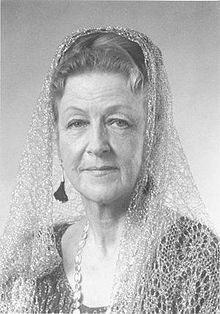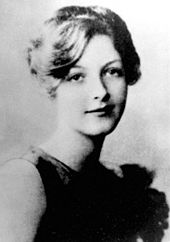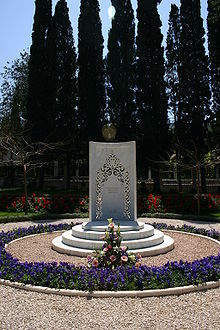- Rúhíyyih Khanum
-
Amatu'l-Bahá Rúhíyyih Khánum (August 8, 1910 – January 19, 2000), born Mary Sutherland Maxwell was the wife of Shoghi Effendi, the head of the Bahá'í Faith from 1921–1957. She was appointed by him as a Hand of the Cause, and served an important role in the transfer of authority from 1957–1963. In 2004, CBC viewers voted her number 44 on the list of "greatest Canadians" on the television show The Greatest Canadian.[1]
Contents
Early life
Rúhíyyih Khánum was born in New York City on August 8, 1910 to William Sutherland Maxwell and May Maxwell,[2] and was raised in Montreal, Québec where her father was an architect. Mary was of Scottish ancestry.[2] In 1912 `Abdu'l-Bahá visited Canada and stayed in the Maxwell’s home. There he met Mary, aged two, and described her as the "essence of sweetness".[3] `Abdu'l-Bahá showed much affection to baby Mary.[4]
Her mother wanted to give Mary an education that was free of the rigidity of the traditional educational methods in the country, and established the first Montessori school in Canada at their residence, and Mary attended the school.[2] Maxwell began reading and writing at a young age and her pastimes included writing poetry, novels and plays.[5] She spoke English, French, German and Persian fluently.[2] During her youth she twice traveled to the Bahá'í World Centre in Palestine for pilgrimage – the first with her mother and the second with her mother's friends aged sixteen. It was during these pilgrimages that she first met Shoghi Effendi, the Guardian of the Bahá'í Faith. After her trips she also engaged in many youth activities in the Bahá'í community, and traveled around the world teaching the Bahá'í Faith.[2]
In her youth Maxwell was engaged in many Bahá’í youth activities.[5] At the age of 15 she joined the Executive Committee of the Fellowship of Canadian Youth for Peace.[5] She was also involved in local racial equality conventions including dances.[6] A spectator – one of the first African-American Bahá’ís[6] – Sadie Oglesby described her as "sixteen-year-old Mary Maxwell, a beautiful and most refreshing girl to know".[6] By twenty-one she was elected to the local Spiritual Assembly of the Bahá'ís of Montreal, the local Bahá'í governing council there.[5]
Marriage and appointed positions
Mary and Shoghi Effendi had met on first when she was on her first pilgrimage in 1923, and at 16 she made her second one. She made her third in early 1937 and the two began a discreet courtship.[7] On March 24, 1937 aged twenty-six she married the Guardian of the Bahá'í Faith, Shoghi Effendi, and it was at this time that she was given the name "Amatu'l-Bahá Rúhíyyih Khánum" by Shoghi Effendi. ("Amatu'l-Bahá" means "Handmaiden of Glory".)[7] The marriage ceremony had been deliberately a reserved and simple one.[7] The two became constant companions and Shoghi Effendi later described Rúhíyyih Khánum as his "shield" and his "helpmate".[5]
Almost immediately after their marriage, she served as the Guardian's secretary, and then in 1941 until 1957 she served as Shoghi Effendi's principal secretary in English.[2] In 1951 she was appointed to the International Bahá'í Council, which was an administrative institution of the Bahá'í Faith created as a precursor to the Universal House of Justice, to act as a liaison between the Council and Shoghi Effendi.[7] Later on March 26, 1952, she was appointed to the office of Hand of the Cause of God – a distinguished rank in service to the religion [8] – for which she attended to issues related to the propagation and protection of the religion.[2]
After Shoghi Effendi died in 1957, she became for Bahá'ís the last remaining link to the family of `Abdu'l-Bahá, who headed the Faith from 1892 to 1921 and was the eldest son of the Faith's Founder, Bahá'u'lláh.
Ministry of the Custodians
In 1957 her husband, Shoghi Effendi, died without having appointed a successor. Rúhíyyih Khánum was among the 27 Hands of the Cause who stewarded the religion for the six-year interim, before the Universal House of Justice was scheduled to be elected in 1963. The Hands voted among themselves for nine individuals to work at the Bahá'í World Centre to run the administration of the Faith, a position to which Rúhíyyih Khánum was elected; these nine were designated the Custodians.[9][10] During this time she worked on assuring the completion of the ten-year international teaching plan which was launched by Shoghi Effendi in 1953.[2] Upon the election of the Universal House of Justice in 1963, the ending point of Shoghi Effendi's ten-year plan, the nine Hands acting as interim head of the Faith closed their office.[9]
Travels
From 1957 until her death Rúhíyyih Khánum traveled to over 185 countries and territories working with the world's several million Bahá'ís; she especially encouraged members of indigenous peoples to participate in the global Bahá'í community.[2] Her travels took her to all the continents and to small islands; some of her travels involved extended stays. For four years she traveled for 58,000 kilometers in a Landrover through sub-Saharan Africa, visiting 34 countries, of which in 17 she was received by the head of state. On another trip she visited nearly 30 countries in Asia and the Pacific islands during a seven month span.[2] From January to March 1970 she crossed Africa from east to west, driving 2/3 of the distance herself, visiting many country's communities, meeting with individuals and institutions both Bahá'í and civic.[11]
In 1975–6 she travelled by boat through the tributaries of the Amazon River of Brazil and also visiting the high mountain ranges of Peru and Bolivia. Thirty six tribal groups were visited over a period of six months; the trip was called The Green Light Expedition,[12][13][14] which followed Khanum's The Great African Safari.[15] There have also been projects developed from the original expedition - In the Footsteps of the Green Light Expedition[16] and Tear of the Clouds.[17]
During her travels she was received by the following heads of state and government; Emperor Haile Selassie of Ethiopia; Malietoa Tanumafili II of Western Samoa; Prime Minister Indira Gandhi of India; President Félix Houphouët-Boigny of Côte d'Ivoire; President Carlos Menem of Argentina; Prime Minister Edward Seaga of Jamaica; and Javier Pérez de Cuellar, Secretary-General of the United Nations.[2]
Death
Rúhíyyih Khánum died on January 19, 2000 at the age of 89 in Haifa, Israel and her resting place is at the Bahá'í World Centre.[2]
Publications
Rúhíyyih Khánum was also an author; she wrote several books including The Priceless Pearl, which is a biography of Shoghi Effendi;[18] Twenty-Five Years of the Guardianship;[19] Prescription for Living, which discussed the application of spiritual principles to one's life.[20] She was also the editor of the book The Ministry of the Custodians.[21]
See also
- Maxwell International Bahai School
Notes
- ^ CBC (2004). "The Greatest Canadian - Top 100 - 11 to 100". CBC.ca. Archived from the original on 2008-04-20. http://web.archive.org/web/20080420130011/http://www.cbc.ca/greatest/greatcanadians/index.html#41. Retrieved 2008-07-05.
- ^ a b c d e f g h i j k l "Amatu'l-Bahá Rúhíyyih Khánum (1910 - 2000)". Bahá'í Community of Canada. http://www.ca.bahai.org/madame-rabbani. Retrieved 2008-07-05.
- ^ Nakhjavani, Violette (2000). Tribute to Amatu'l-Baha Rúhíyyih Khánum, A. Bahá'í Canada Publications & Nine Pines Publishing, Ottawa, Canada. ISBN 0888671059.
- ^ Thompson, Juliet (1983). The Diary of Juliet Thompson. Los Angeles: Kalimat Press. http://bahai-library.com/thompson_diary.
- ^ a b c d e "Madame Rúhíyyih Rabbáni, leading Bahá'í dignitary, passes away in Haifa". One Country: Online Newsletter of the Bahá'í International Community. http://www.onecountry.org/e114/e11401as_Rabbani_passing.htm.
- ^ a b c Etter-Lewis, Gwendolyn (2006). Lights of the Spirit: Historical Portraits of Black Baha'is in North America, 1898-2000. Baha'i Publishing Trust. p. 80. ISBN 1931847266.
- ^ a b c d Smith, Peter (2000). "Rúhíyyih Khánum, Amatu'l-Bahá". A concise encyclopedia of the Bahá'í Faith. Oxford: Oneworld Publications. pp. 299–300. ISBN 1-85168-184-1.
- ^ Compilations (1983). Hornby, Helen (Ed.). ed. Lights of Guidance: A Bahá'í Reference File. Bahá'í Publishing Trust, New Delhi, India. p. 322. ISBN 8185091463. http://bahai-library.com/hornby_lights_guidance_2&chapter=2#1079.
- ^ a b Taherzadeh, Adib (2000). The Child of the Covenant. Oxford, UK: George Ronald. pp. 368–371. ISBN 0853984395.
- ^ Vafai, Shahin (2005). "Chapter 5". The Essence of the Covenant. Riviera Beach, Fl: Palabra Publications. ISBN 1890101273.
- ^ "Hand of the Cause of God Rúhíyyih Khánum Travels Six Thousand Miles Across Africa". Bahá'í News (209): p. 3–18. June 1970. http://www.teachingandprojects.com/meansandmaterials.htm.
- ^ Amatu'l-Baha Rúhíyyih Khánum (2000). The Green Light Expedition (film, remastered DVD). National Spiritual Assembly of the Bahá'ís of Canada. http://www.bahaibookstore.com/productdetails.cfm?PC=7014.
- ^ Bahá'í International Community (2003-11-28). "Standing up for the oneness of humanity". Bahá'í World News Service (Cuidad Colon, Costa Rica). http://news.bahai.org/story/250.
- ^ Sadan, Mark (2007). "Mark Sadan - photographer, filmaker, U.S.A". BAFA Newsletter (Bahá'í Association for the Arts & Arts Dialogue). http://bahai-library.com/bafa/s/sadan.htm.
- ^ Palin, Iain S. (2002). "Book Review". Journal of the Bahá'í Community of the United Kingdom of Great Britain and Northern Ireland (National Spiritual Assembly of the Bahá'ís of the United Kingdom) 19 (2). http://www.bahaijournal.org.uk/BJ200206/review.htm. Retrieved 2008-03-09.
- ^ Beers, Karim (2007). "EBBF Profile: Neissan Alessandro Besharati: Flowing Together--Sustainability, Interconnectedness and Income-generation in the Amazon". INSPIRE (European Bahá’í Business Forum) (16). http://ebbf.org/ebbforg/neissan_besharati.html. Retrieved 2010-12-07.
- ^ Sadan, Mark; Kelly, Rebecca. "Tear of the Clouds". Market Group Ventures Inc.. http://www.rizvanart.com/finearts/marksadan/tear.shtml. Retrieved 2008-03-09.
- ^ Rabbani, R. (1969). The Priceless Pearl (Hardcover ed.). London, UK: Bahá'í Publishing Trust: 2000. ISBN 1870989910.
- ^ Rabbani, R. (1948). Twenty-Five Years of the Guardianship. Wilmette, Illinois, USA: Bahá'í Publishing Trust. http://bahai-library.com/khanum_25_years_guardianship.
- ^ Rabbani, R. (1978). Prescription for Living. George Ronald. ISBN 0853980039. OCLC 7260143.
- ^ Rabbani, R., ed (1992). The Ministry of the Custodians 1957-1963. Bahá'í World Centre. ISBN 085398350X. http://bahai-library.com/uhj_ministry_custodians.
References
- Harper, Barron (1997). Lights of Fortitude (Paperback ed.). Oxford, UK: George Ronald. ISBN 0853984131. OCLC 156803406.
- Nakhjavani, Violette (2000). Tribute to Amatu'l-Baha Rúhíyyih Khánum, A. Bahá'í Canada Publications & Nine Pines Publishing, Ottawa, Canada. ISBN 0888671059.
- Rabbani, Ruhiyyih (Ed.) (1992). The Ministry of the Custodians 1957-1963. Bahá'í World Centre. ISBN 085398350X. http://bahai-library.com/uhj_ministry_custodians.
- Rabbani, Ruhiyyih (1969). The Priceless Pearl (Hardcover ed.). London, UK: Bahá'í Publishing Trust: 2000. ISBN 1870989910.
- Rabbani, R. (1948). Twenty-Five Years of the Guardianship. Wilmette, Illinois, USA: Bahá'í Publishing Trust. http://bahai-library.com/khanum_25_years_guardianship.
External links
Bahá'í Faith Central figures 
Scripture Key figures Principal teachings See also Symbols · Texts · Teachings · Laws · History · Administration · Calendar · Pilgrimage · Prayer · CategoryCategories:- Canadian Bahá'ís
- Hands of the Cause of God
- Bahá'í holy family
- American emigrants to Canada
- Canadian people of Scottish descent
- People from New York City
- People from Montreal
- 1910 births
- 2000 deaths
- 20th-century Bahá'ís
Wikimedia Foundation. 2010.



